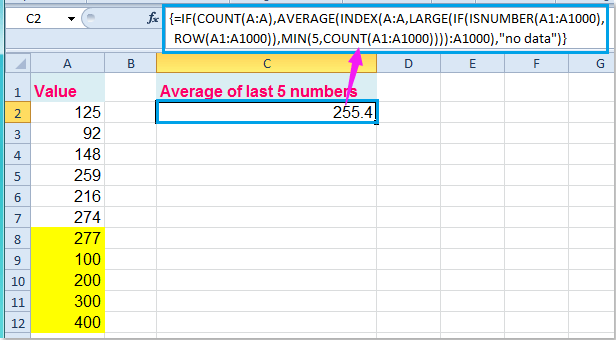Bagaimana rata-rata 5 nilai terakhir dari kolom saat angka baru masuk?
Di Excel, Anda bisa dengan cepat menghitung rata-rata 5 nilai terakhir dalam kolom dengan fungsi Rata-rata, tetapi, dari waktu ke waktu, Anda perlu memasukkan angka baru di belakang data asli Anda, dan Anda ingin hasil rata-rata akan berubah secara otomatis sebagai data baru masuk. Artinya, Anda ingin rata-rata selalu mencerminkan 5 angka terakhir dari daftar data Anda, bahkan saat Anda menambahkan angka sesekali.
Rata-rata 5 nilai terakhir kolom sebagai angka baru yang dimasukkan dengan rumus
 Rata-rata 5 nilai terakhir kolom sebagai angka baru yang dimasukkan dengan rumus
Rata-rata 5 nilai terakhir kolom sebagai angka baru yang dimasukkan dengan rumus
Rumus array berikut dapat membantu Anda memecahkan masalah ini, lakukan hal berikut:
Masukkan rumus ini ke dalam sel kosong:
=IF(COUNT(A:A),AVERAGE(INDEX(A:A,LARGE(IF(ISNUMBER(A1:A10000),ROW(A1:A10000)),MIN(5,COUNT(A1:A10000)))):A10000),"no data") (A: A adalah kolom yang berisi data yang Anda gunakan, A1: A10000 adalah rentang dinamis, Anda dapat mengembangkannya selama kebutuhan Anda, dan jumlahnya 5 menunjukkan nilai n terakhir.), lalu tekan Ctrl + Shift + Enter kunci bersama untuk mendapatkan rata-rata dari 5 angka terakhir. Lihat tangkapan layar:

Dan sekarang, ketika Anda memasukkan angka baru di belakang data asli, rata-rata akan berubah juga, lihat tangkapan layar:

Note: Jika kolom sel berisi nilai 0, Anda ingin mengecualikan 0 nilai dari 5 angka terakhir Anda, rumus di atas tidak akan berfungsi, di sini, saya dapat memperkenalkan rumus array lain untuk mendapatkan rata-rata dari 5 nilai bukan nol terakhir , masukkan rumus ini:
=AVERAGE(SUBTOTAL(9,OFFSET(A1:A10000,LARGE(IF(A1:A10000>0,ROW(A1:A10000)-MIN(ROW(A1:A10000))),ROW(INDIRECT("1:5"))),0,1))), lalu tekan Ctrl + Shift + Enter kunci untuk mendapatkan hasil yang Anda butuhkan, lihat tangkapan layar:

Artikel terkait:
Bagaimana rata-rata setiap 5 baris atau kolom di Excel?
Bagaimana rata-rata nilai 3 atas atau bawah di Excel?
Alat Produktivitas Kantor Terbaik
Tingkatkan Keterampilan Excel Anda dengan Kutools for Excel, dan Rasakan Efisiensi yang Belum Pernah Ada Sebelumnya. Kutools for Excel Menawarkan Lebih dari 300 Fitur Lanjutan untuk Meningkatkan Produktivitas dan Menghemat Waktu. Klik Di Sini untuk Mendapatkan Fitur yang Paling Anda Butuhkan...

Tab Office Membawa antarmuka Tab ke Office, dan Membuat Pekerjaan Anda Jauh Lebih Mudah
- Aktifkan pengeditan dan pembacaan tab di Word, Excel, PowerPoint, Publisher, Access, Visio, dan Project.
- Buka dan buat banyak dokumen di tab baru di jendela yang sama, bukan di jendela baru.
- Meningkatkan produktivitas Anda sebesar 50%, dan mengurangi ratusan klik mouse untuk Anda setiap hari!
